Managing users and profile settings
This guide shows you how to manage users in an environment or organization when you’re the administrator or owner of the Prepr account. Additionally, you can learn how to manage your own account profile as a standard Prepr user.
Managing user accounts
There are two ways to manage user accounts: on the organization level and on the environment level. A user can have other different roles in separate environments. For example, the Admin role in one environment and the Editor role in another. Check out the Roles and permissions doc for more details about Role-based access control for users. We recommend managing your user accounts on the organization level.
Add users - organization level
To create a user account on the organization level, complete the following steps:
- Click the environment dropdown at the top right, choose your organization and click to open the environments overview.
- Go to the User management page to open a list of all users in the environments of your organization.
- Simply click the Add User button and fill in the user details. The First name and the Email address are required.
You can manage user accounts if your role has the Users organization permission enabled.
-
Choose the Language of this user (default English) and choose the User expiration date for this user account, if needed.
-
And lastly, choose the requested Environment and the corresponding Role of this user. For more details, check out the Managing user roles doc. Choose at least one role per environment. When saving a new user, an invitation email will be sent to the given email address. When saving an existing user, their account will be updated immediately with the changed permissions or roles.
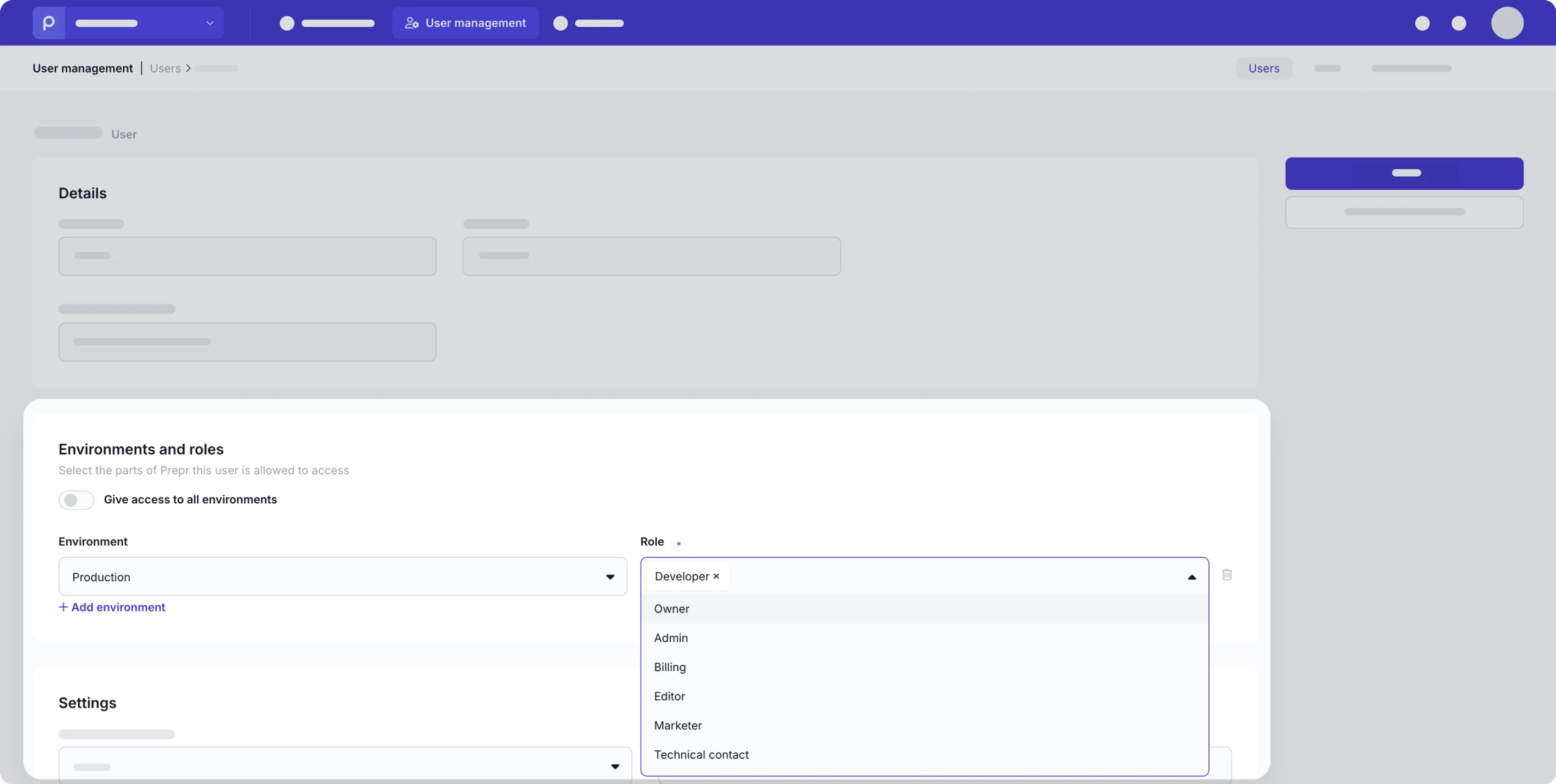
Add users - environment level
To create a user account in the environment directly, follow the steps below.
- Go to Settings → Users to open a list of all users in this environment.
- Simply click the Add user button and fill in a few user details. The First name and Email address are required.
- Choose the language of this user (default English) and the User expiration date for this user account, if needed.
- Finally, choose the Role for this user. See the Managing user roles doc for more details. Choose at least one role. When saving a new user, an invitation email will be sent to the given email address. When saving an existing user, their account will be updated immediately with the changed permissions or roles.

Send invitation to sign in
When you create a new user and click the Save button, the user will receive an email with sign-in instructions.

The invitation expires after 7 days. If the recipient has an active email SPAM filter and Prepr emails end up in the SPAM box, the link expires after 12 hours.
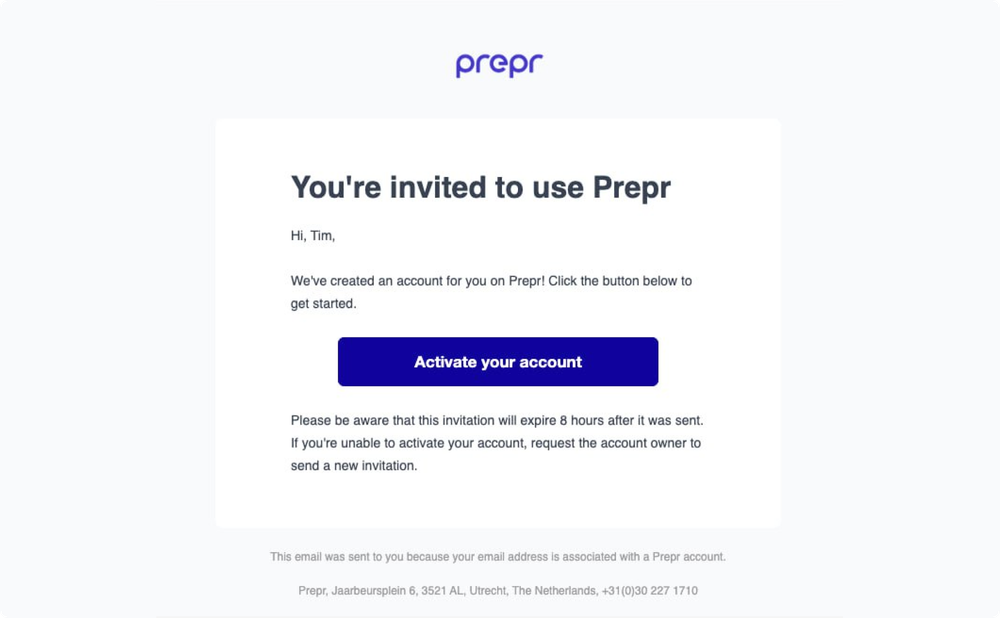
To activate their account, they need to click the Activate your account button to go through the Prepr onboarding flow.
This link in the email expires after 7 days. If the user forgets to accept the invitation and wants to set a password after these 7 days, they need to click the Reset password link on the Prepr sign-in page.

Resend the activation link to sign in
Alternatively, you can resend invitations as long as the user has never signed in. A user that has not yet signed in can be recognized by the Invited label behind his name in the Users overview page. You can either choose to copy the activation link and send it directly through a messaging app or you can resend the invitation email.
-
To copy the activation link, hover over the user and click the icon.

-
To resend the invitation email, hover over the user and click the icon.

When the user clicks the link you’ve messaged them or from the invitation email, they are prompted to enter their personal details to complete the onboarding.

Passwords must be at least 8 characters and contain at least one uppercase letter, one lowercase letter and a number. To finalize your account activation, click the Let’s go button. You are now logged in.

Delete users
When a user account is no longer needed, you can Delete the user if you have the permission to do so, usually as an Admin user or the Owner of the Prepr account. This can be done in one of two ways.
-
From the Users page, hover over the user you want to delete and click the icon to delete this user

-
Or click the user that you want to delete to open the the User detail page and click the Delete button.
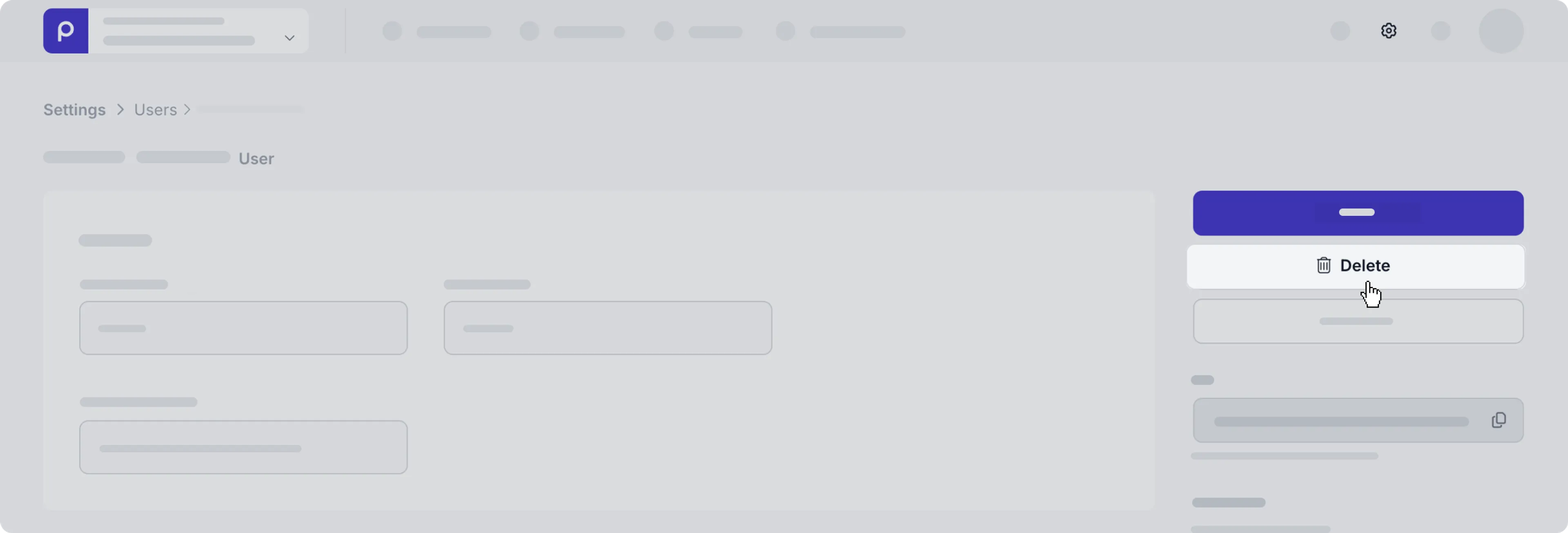
Agency accounts
Agency accounts are user accounts of (web) agencies that take care of the implementation of your website or app. These accounts do not count toward the number of users you can add within your license. You, therefore, do not pay for agency accounts. Agency users need to use 2FA to sign in. Become a Prepr partner to register your agency account in Prepr.

Agency users can only be edited and managed in the agency environment.
Define user expiration date
You can manage the period a user can have Prepr access. Click the icon and choose the Users option. Click the user that you want to manage.
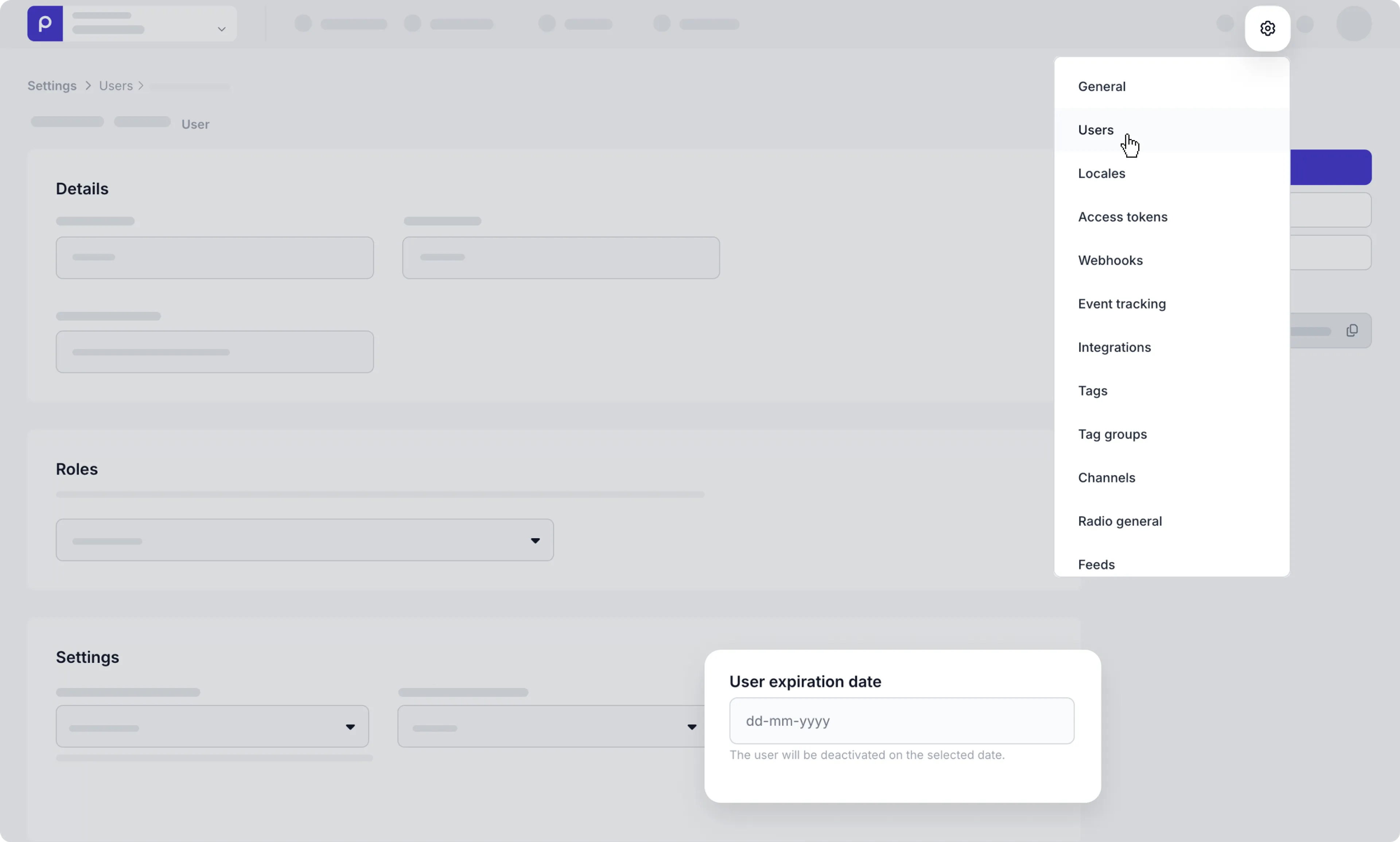
Update the User expiration date field on the user detail page. Select the date the account needs to expire or leave it empty to give a user lifetime access.
Prepr sends a notification to the user seven days before the user account expires. One day before the expiration date, the owner of the environments gets a notification email.
After this period, the user access will be revoked. When this user tries to log in, the following message is shown to this user: Your account has expired. Contact your admin if you need access.
Any user that has a role (such as the Owner or Admin role) with the Users permission enabled can grant access to the expired user again.

Managing your account profile
Any Prepr user can manage their own account profile settings by clicking their avatar at the top right of the screen.

Switch to light/dark mode
You can easily switch between light and dark mode in Prepr by clicking your avatar at the top right of the screen and choosing either the Light, Dark or System option.
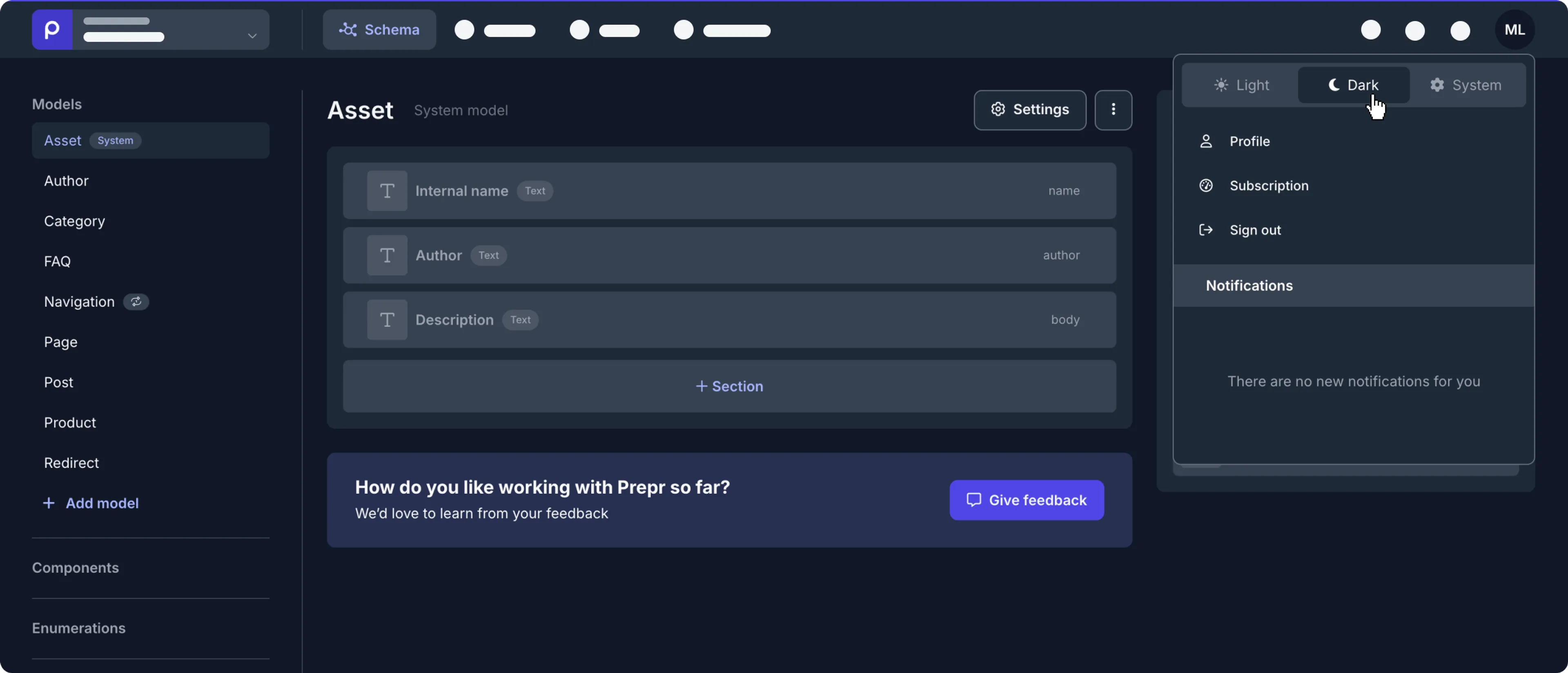
-
Light - the standard theme with a white background.
-
Dark - uses dimmer background colors and brighter foreground colors to ensure the interface has sufficient contrast and to help reduce eye strain.
-
System - depends on your system settings (Windows, OS).
Activate two-factor authentication
Two-factor authentication (2FA) adds a second layer of login security to your Prepr account. Any user can set up 2FA individually by themselves. With 2FA enabled, you’ll be asked to provide a 6-digit code after you’ve signed in with your login credentials. Each code is unique, and can only be used once to log in.
2FA is required for all users with an Owner or Admin role in a Prepr organization with a paid subscription.
To enable two-factor authentication, perform the following steps:
-
First, download an authenticator app, such as Google Authenticator or Authy from your mobile device.
-
Log in to Prepr and click your avatar on the top right and choose the Profile option to open your account profile details.
-
Then, click the Enable two-factor authentication toggle.
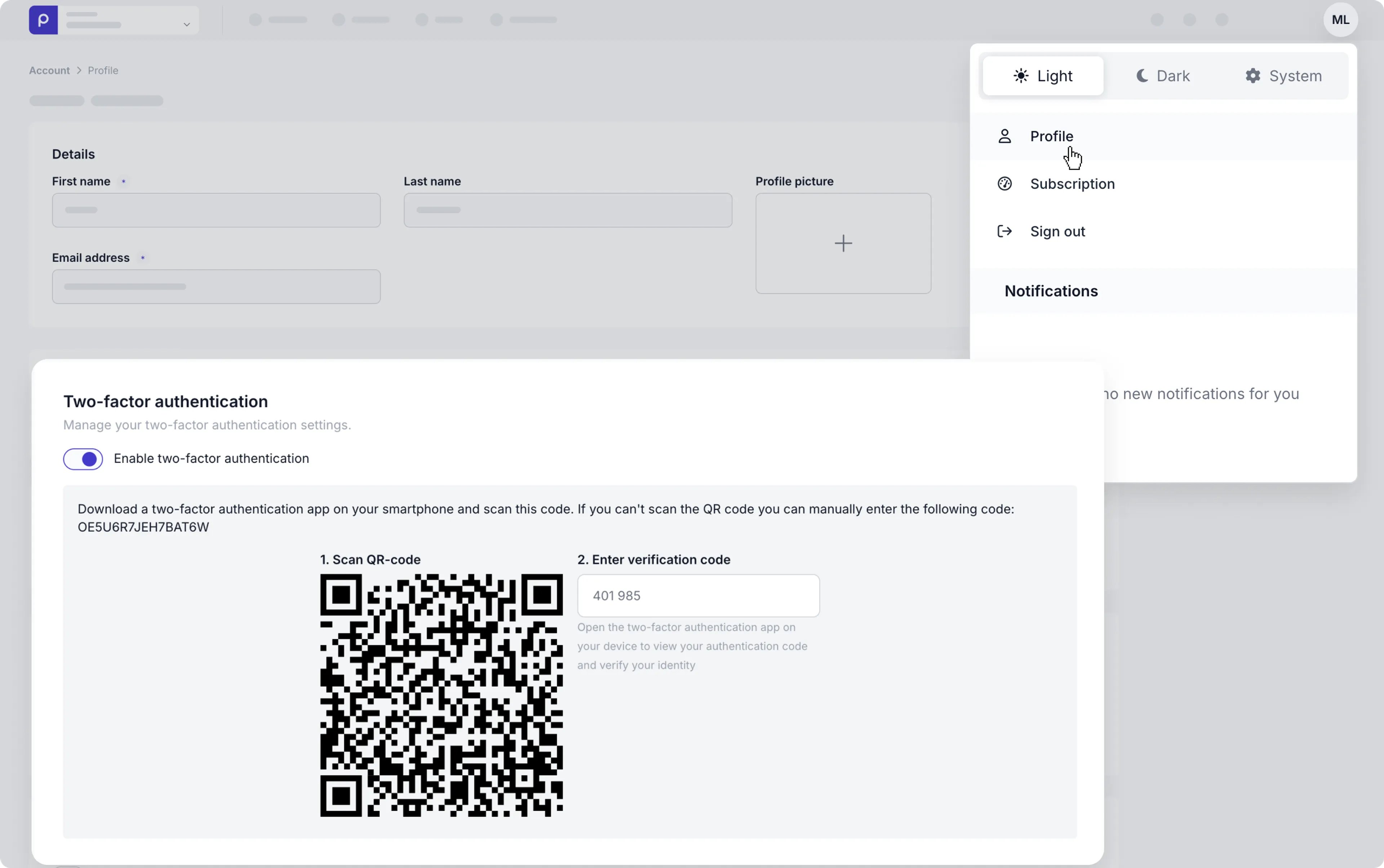
-
Scan the QR code with your smartphone. If you can’t scan the QR code you can manually enter the 6-digit verification code generated by your authenticator app. Two-factor authentication is now enabled for your account.
To deactivate the 2FA, simply click the same toggle in your account profile.
In the event that you lose access to your 2FA device, contact our support team. After successful verification, they can deactivate 2FA for your account.
- When 2FA is enabled, the next time you log in with your email and password, you need to provide the special verification code you see in your authenticator app before you can complete the sign-in process. Each code is unique, and can only be used once to log in.

Add passkeys
Passkeys allow you to log in to Prepr using your device’s security features like a fingerprint, face scan, or PIN, instead of a traditional password.
To add passkeys to your account profile, follow the steps below.
-
Log in to Prepr and click your avatar on the top right and choose the Profile option to open your account profile details.

-
Click the + Add passkey link and choose your preferred passkey saved on your device.

-
Change the default name for the passkey if you’d like and click the Save button to save the passkey in your profile. You can then add another passkey, if needed.
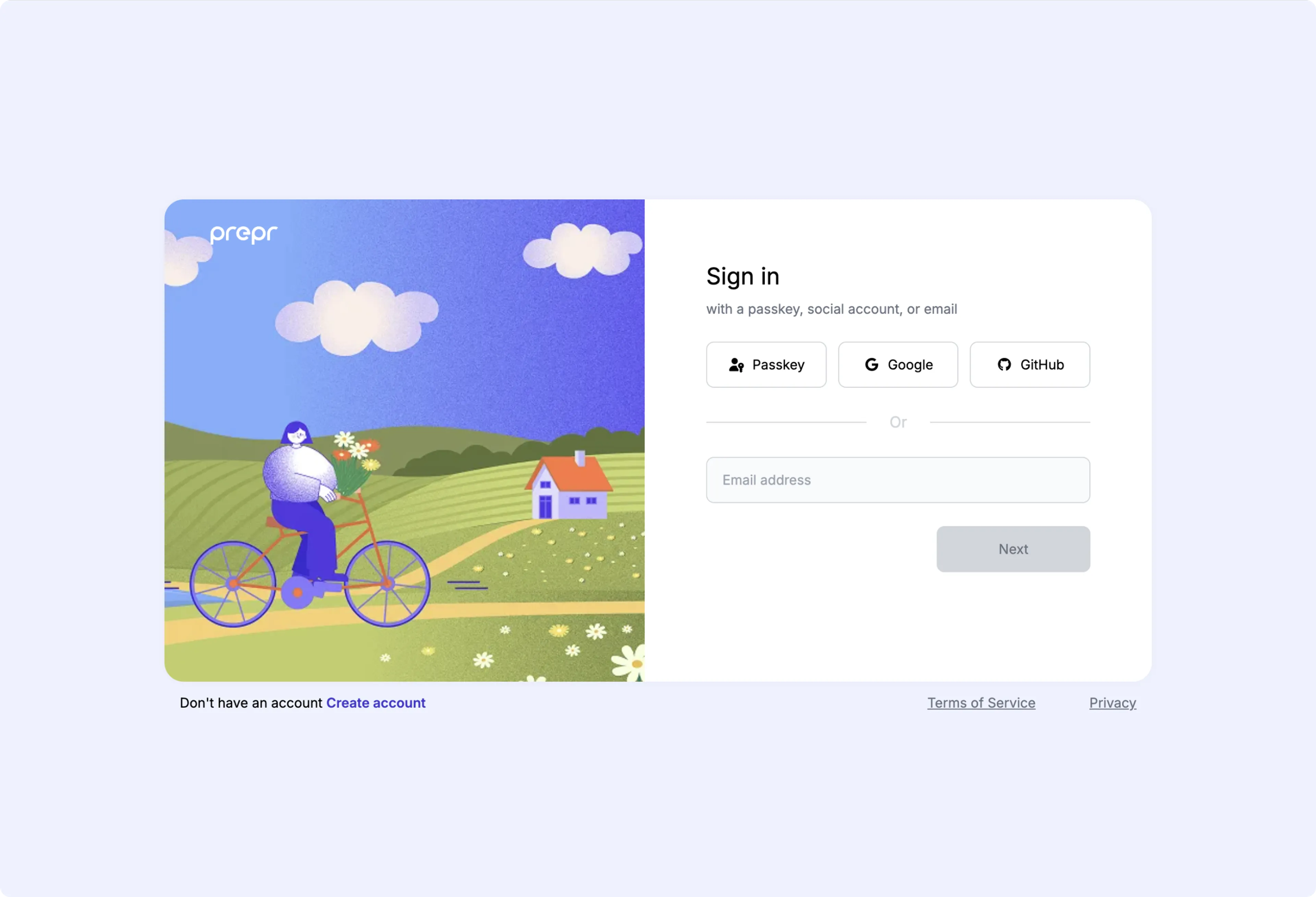
The next time you access the sign-in screen, you can then choose the Passkey button to log in.
Set language preferences
Go to the Settings in your account profile to change your personal language preferences.
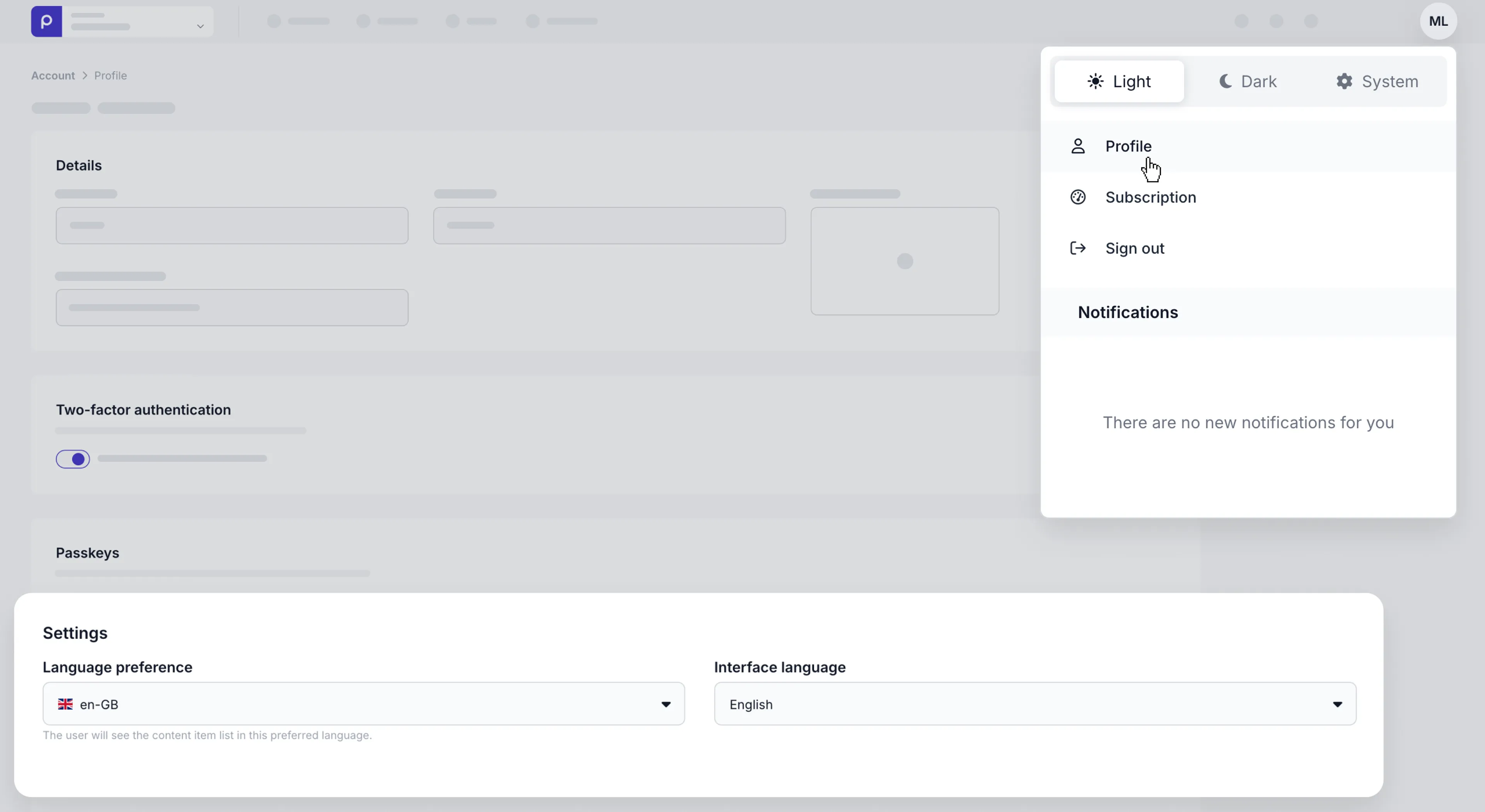
When working in a multilingual environment, you can define your preferred language for content items.
For example, if you usually work and translate content items to English, but the environment default is Dutch, you can set your Language preference to en-US for instance.
For more details, check out the localization doc.
In addition to the language preference for content items, you can also choose between English, Dutch and French for the Prepr Interface language.
Manage your personal notifications
Prepr gives you the option to be notified of events in the application. This way you are always aware of events that are relevant to you. You can receive notifications via the Prepr application, via browser notifications, and via email.
To activate personal notifications, you can enable notifications by following the steps below.
-
Log in to Prepr and click your avatar on the top right and choose the Profile option to open your account profile details.
-
Scroll down and click the Enable notifications toggle to choose the triggers and type of notification, via email or in the browser.

There are three types of notifications you can receive.
-
Application notifications
You will always see these notifications in the Prepr application. Click your avatar at the top right of the screen to see these notifications.
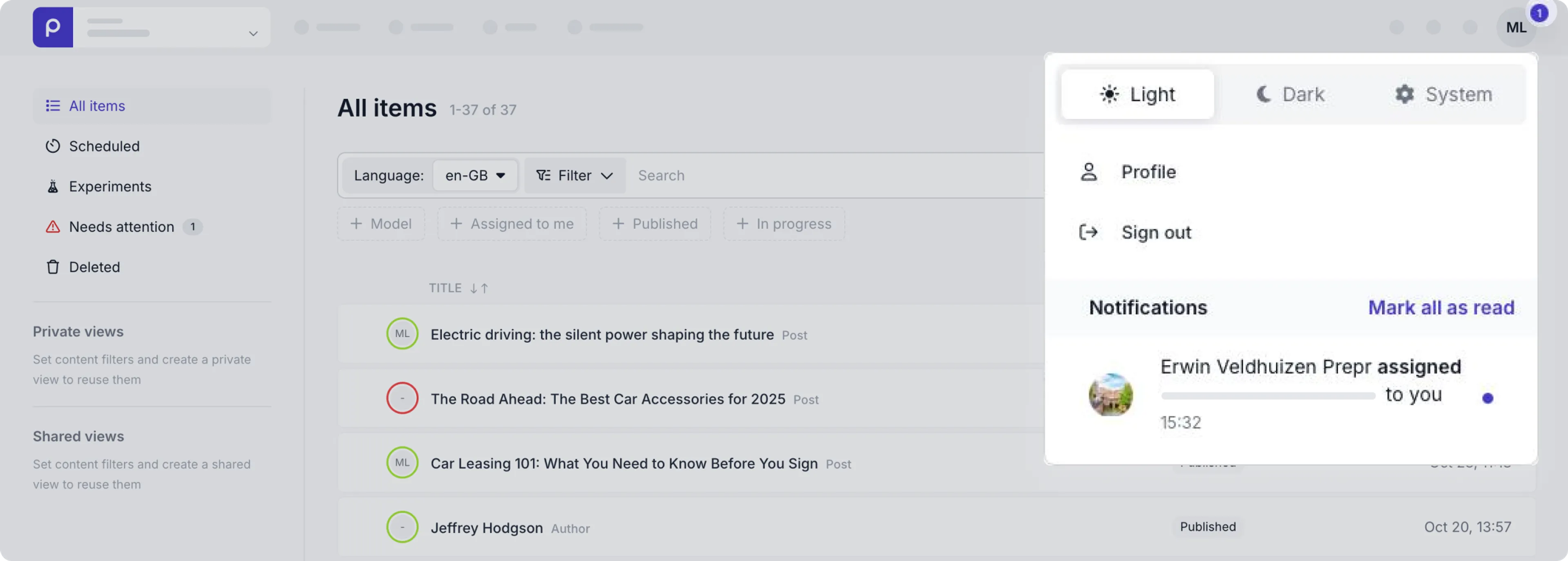
You can then click the Mark all as read link to empty the notification list.
-
Email notifications
You can also receive notifications via email. The email always contains an action button, so that you can immediately read the comment, go to the user list or check the webhook edit page.

-
Browser notifications
You can receive system notifications via your web browser. To receive browser notifications, you need to allow notifications in your browser and your Operating System. For these, make sure the Do Not Disturb option is disabled.

There are several events that you can choose to trigger notifications.
-
When I get mentioned in a content item
You get this notification if someone mentions you when adding a comment to a content item.
-
When a content item gets assigned to me
You get this notification if someone assigns any content items to you.
-
When a webhook is failing
Check out the webhooks guide for more details on webhook responses. We recommend developer users enable this notification.
-
When a remote source synchronization is disabled
This notification is useful for developers who manage the integration of content items from remote sources.
-
When a new user is signed in via SSO
A new Prepr user who logs in to the application for the first time using single sign-on will not yet have permissions. The owner, or another Prepr user with access to user management, must provide him with the correct permissions. You can enable this notification to check when users log in with SSO for the first time.